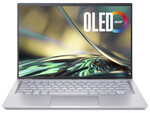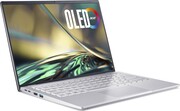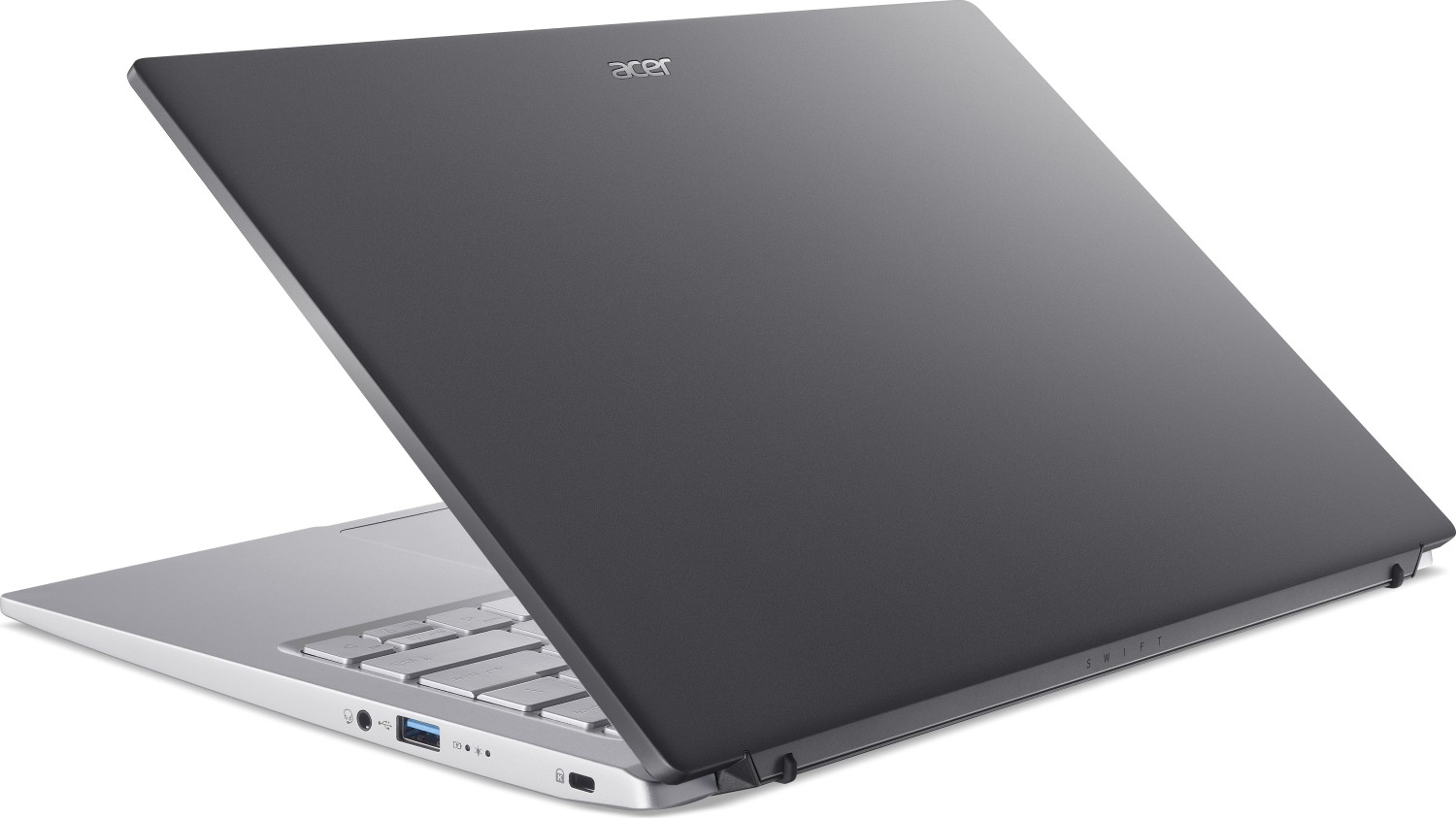Acer Swift 3 SF314-71-751E
Especificações do Portátil

Price comparison
Média de 6 pontos (das 10 análises)
Análises para o Acer Swift 3 SF314-71-751E
Origem: Expert Reviews
 EN→PT
EN→PTThe latest Swift 3 has all the strengths that have made it a perennial favourite here at Expert Reviews, but now it has the added appeal of Alder Lake power and a cracking 2.8K OLED display. Battery life has taken a hit, but the new chip and display were always going to have that effect. The new model is naturally more expensive than the old one but that too was to be expected. Is it still our favourite machine in this class? That’s a tough question to answer because the new Pavilion Plus 14 is very strong competition. It all comes down to the question “Do you want a discrete GPU”? If you do, buy the HP, if you don’t, I would lean towards the Acer. Both are very fine laptops.
Análise única, Disponível online, Longa, Data: 02/27/2023
Pontuação: Pontuação total: 100%
Origem: The Verge
 EN→PT
EN→PTThe case for the Acer Swift 3 is: It is one of the most powerful laptops, with one of the best screens you can get, available in the $1,200 range. With a portable build, it can be a great choice for both multimedia viewing and demanding work on the go. This has the potential to be a very unique and effective device. It’s just a shame how much the short battery life weakens that case, because there’s absolutely an audience for a powerful 14-inch laptop with a great screen. I understand that some shoppers — even those shopping in the 14-inch category — don’t care about battery life. That, to me, doesn’t mean it’s acceptable for companies to ask such large compromises of their buyers. I don’t completely blame Acer for this, as it’s been a consistent issue with Intel devices over the past year. But this is a poor result even among those products, and the corresponding extra power the H-series chip brings over the P-series (which is identical in architecture) is not as valuable for an ultraportable as it would be for a bigger workstation. And media creators who are wed to Windows can expect a much longer lifespan out of all kinds of portable OLED devices — the Dell XPS 13 Plus, for example, and various members of Asus’ Zenbook line — without a massive compromise on performance.
Análise única, Disponível online, Média, Data: 02/23/2023
Pontuação: Pontuação total: 60%
Origem: Mobile Tech Review
 Archive.org version
Archive.org versionAs you might guess from the name, the Acer Swift 3 OLED 14” laptop has an OLED display. That’s a welcome feature in a mid-priced laptop, as is the 45 watt Intel 12th gen processor that’s more commonly found on mobile workstations and gaming laptops. The Acer is an aluminum clad Ultrabook-sized laptop that’s an easy carry. The 90Hz OLED display is 2.8K resolution, and you can get the PC with up to 16GB RAM and 1TB storage. It starts at $900 list.
Análise única, Disponível online, Longa, Data: 11/18/2022
Origem: Techradar
 EN→PT Archive.org version
EN→PT Archive.org versionThe Acer Swift 3 OLED is a follow-up to one of the finest laptops ever made, the Acer Swift 3, as well as the Acer Swift 5 touchscreen. However, not a touchscreen like the others, this laptop's main draw is its bright and absolutely stunning OLED screen which also supports HDR. Unlike many of the best Ultrabooks, this one is priced exceptionally reasonably, with its most expensive model only $1,300 (around £1,065 / AU$1,815). Currently, though, its availability is very rough, with it being sold out at the limited retailers that had it in the US and nonexistent in other regions like the UK and Australia. Hopefully, it comes back in stock soon as it’s a gorgeous laptop with a sleek and sexy silver chassis, beautiful backlighting on the keyboard that makes it looks almost crystal-like, and a smooth and responsive touchpad. It’s also incredibly thin and lightweight at only three pounds, ideal for portability. It’s genuinely shocking how easy it is to carry this laptop around.
Análise única, Disponível online, Longa, Data: 11/15/2022
Pontuação: Pontuação total: 90%
Origem: Reviewed.com
 EN→PT Archive.org version
EN→PT Archive.org versionAcer’s Swift 3 OLED is not the flashiest productivity laptop around, but it has a ton of performance thanks to Acer’s smart decision to outfit one of its most popular laptops with an H-series Intel processor instead of a P-series. The OLED display’s excellent color accuracy and wide color gamut make the Swift 3 a surprisingly good machine for light photo and video work, even some 3D image rendering. However, its Achilles heel is not its design or even its audio, but its battery life. Crashing just before the six-hour mark means you will need to carry the adapter with you if you leave your house with anything less than a full charge. You can avoid this by looking for another laptop with an Intel P-series processor or an AMD Ryzen U-series processor, but you’ll have to be fine with a slower laptop. If speed is not something you can compromise on, but you’re working with less than $1,000, consider grabbing the base model of the Swift 3 OLED with the Intel Core i5-12500H. It’s slower but less-power-hungry, so you’ll get a little more battery life out of the laptop
Análise única, Disponível online, Média, Data: 10/05/2022
Origem: Digital Trends
 EN→PT Archive.org version
EN→PT Archive.org versionIn the end, there’s much to like about the Swift 3 OLED. It leverages its faster CPU, unlike some other 14-inch machines, and its OLED display is as good as it gets. Its build quality is solid for a midrange machine, although not the best in its class, and its connectivity and keyboard are excellent. The touchpad’s too small and the battery life is too short, which are the laptop’s two most significant weaknesses. But even so, it competes well against the two most pertinent alternatives in the HP Pavilion Plus 14, which is available in one configuration for around $400 less, and the Asus Vivobook S 14X, which is closer in price. And you’re only paying $100 more compared to the non-OLED Swift 3, which makes the OLED version a relative bargain. The Swift 3 OLED’s price might be a smidge too high, but it’s mostly justified. So, should you buy it? Yes, if faster performance to go with the spectacular display is your objective. You’ll suffer in battery life, but outside of the one incredibly low-cost HP Pavilion Plus 14 configuration, the Swift 3 OLED provides a compelling enough value to belong on anyone’s shortlist.
Análise única, Disponível online, Longa, Data: 09/05/2022
Pontuação: Pontuação total: 70%
Origem: PC Welt
 DE→PT
DE→PTAnálise única, Disponível online, Longa, Data: 01/29/2023
Origem: Computerhoy
 ES→PT Archive.org version
ES→PT Archive.org versionAnálise única, Disponível online, Longa, Data: 11/04/2022
Pontuação: Pontuação total: 90%
Origem: Charles Tech
 FR→PT Archive.org version
FR→PT Archive.org versionAnálise única, Disponível online, Muito longa, Data: 09/24/2022
Pontuação: Pontuação total: 88% desempenho: 90% pantalha: 100% mobilidade: 90% ergonomia: 90%
Origem: Jagat Review
 ID→PT Archive.org version
ID→PT Archive.org versionAnálise única, Disponível online, Muito longa, Data: 08/12/2022
Comentario
Intel Iris Xe G7 96EUs:
Placa gráfica integrada no Intel Tiger Lake G4 SoCs baseada na nova arquitetura Gen. 12 com 96 EUs (Execution Units / Shader Cluster). A taxa de relógio depende do modelo do processador. Os chips Tiger Lake são produzidos no moderno processo de 10nm+ na Intel.
Estas placas também devem ser capazes de agüentar todos os jogos atuais, mas a maioria deles em configurações de detalhes médios e baixos e com baixas resoluções. Jogos mais antigos, ou menos exigentes ainda podem ser jogados com boa qualidade de gráficos.
>> Mais informação pode ser encontrada na nossa Comparativa de de Placas de Vídeo e a Benchmark Lista.
i7-12700H:
Um processador móvel à base de Alder-Lake com 6 núcleos de desempenho e 8 núcleos eficientes. Os núcleos de desempenho oferecem hiper-roscagem, permitindo o processamento de 20 roscas. O processador funciona a frequências que vão de 1,7 a 4,7 GHz e suporta vPro.
>> Mais informação pode ser encontrada na nossa Comparativa de Processadores Móveis.





